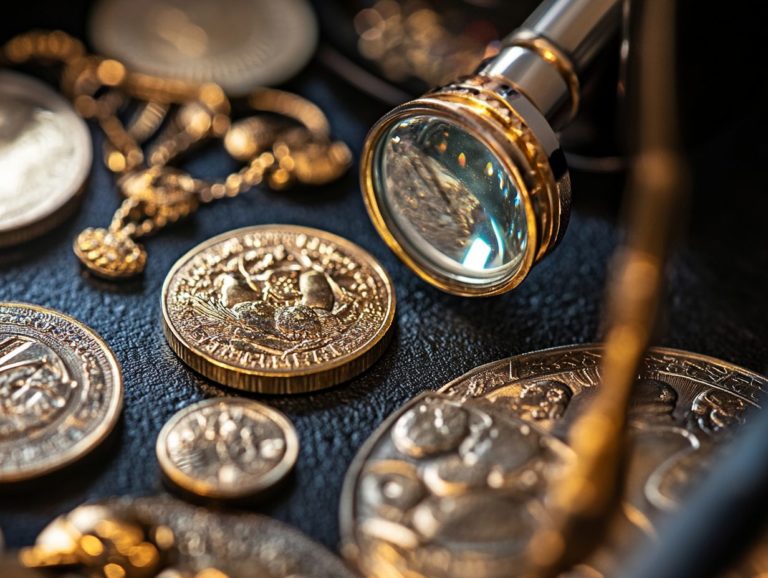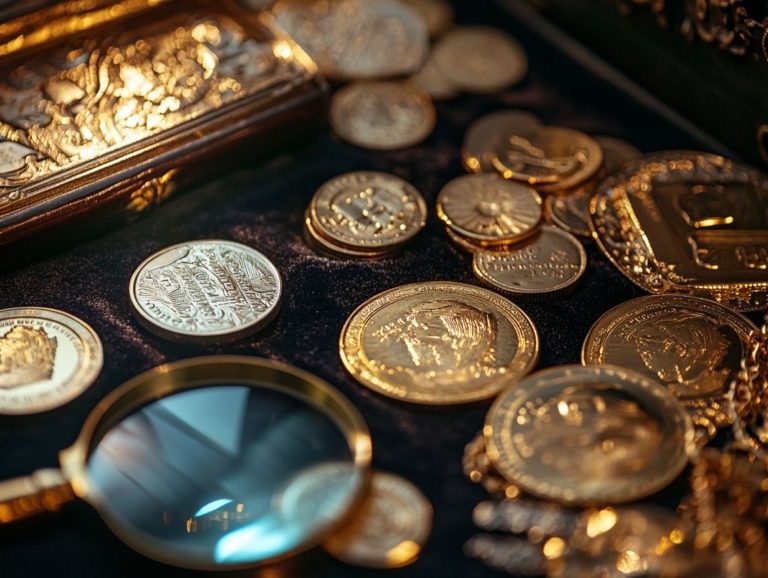Understanding the Basics of Gold Assaying
Gold assaying is an essential process that determines the quality and purity of gold. It serves as a cornerstone in industries ranging from jewelry production to gold mining.
This article will guide you through the definition and purpose of gold assaying, diving into common methods employed, such as fire assay and atomic absorption spectrometry.
You ll discover the importance of obtaining accurate results, the various factors that can influence those results, and how to interpret assay findings effectively.
Join in as you uncover the crucial elements of gold assaying and its real-world applications.
Contents
Key Takeaways:

Gold assaying is a method used to determine the purity and quality of gold through various analytical techniques. Understanding gold grades and impurities is crucial in interpreting assay results, as it affects the value and potential uses of gold. Gold assaying plays a vital role in quality control and purity determination, making it essential in industries such as jewelry production and gold mining.
What is Gold Assaying?
Gold assaying is a pivotal process in checking how pure, good, and genuine gold and other precious metals are. This meticulous method supports both investors and traders by delivering precise assay certificates that detail the composition and karat of gold pieces. This significantly impacts their market value.
The accuracy and transparency in gold assaying are essential for fostering trust within the gold market. This is particularly important considering gold s long-standing role as a cornerstone of wealth and investment.
Definition and Purpose
The definition of gold assaying encompasses evaluating the purity and quality of gold using various testing methods. This essential procedure not only ensures the authenticity of a gold asset but also establishes its market value.
By determining the precise gold content within a sample, you empower yourself to make informed decisions about purchases and sales. For example, understanding the specific karat or percentage of pure gold enables you to verify whether the price accurately reflects the true value or if there’s a risk of encountering fraud.
Ultimately, gold assaying serves as an essential tool in the competitive market, guiding you through the complexities of gold investments and fostering trust in your financial dealings.
Methods of Gold Assaying
Gold assaying uses various methods. These methods help ascertain the purity and composition of gold, providing you with accurate and reliable results essential for well-considered choices in the gold market.
Fire Assay
Fire assay is a traditional and highly precise method for determining the gold content in a sample, often favored by discerning gold traders and investors. This esteemed process involves several critical steps:
- The careful preparation of the sample,
- Fusion with a suitable flux, a substance that helps purify the gold,
- The subsequent separation of gold from other materials through cupellation, the process of separating gold by heating it in a furnace.
Each phase is performed with meticulous attention to detail to ensure accuracy, as even the slightest oversight can lead to significant discrepancies in the results. Fire assay remains the gold standard among assay methods due to its unparalleled accuracy and reliability, which are essential for maintaining trust in the gold market.
This method provides a level of assurance that supports well-considered choices, enhancing your confidence in the value of your investments and the integrity of the market.
Atomic Absorption Spectrometry
Atomic absorption spectrometry is a sophisticated technique that allows you to analyze the purity of gold and other metals by measuring the absorption of specific wavelengths of light.
In this method, you’ll introduce a sample into a flame or graphite furnace, where it gets atomized, allowing the individual metal atoms to absorb light at their characteristic frequencies.
One of the standout benefits of atomic absorption spectrometry compared to traditional assay methods is its exceptional sensitivity and precision. This enables the detection of trace elements that might otherwise slip under the radar.
Regarding gold assays, this technique ensures you receive reliable results, empowering you to make informed decisions in the precious metals market. The accuracy provided by atomic absorption spectrometry is essential for anyone looking to maximize their investments, as it substantiates gold purity claims with solid empirical data.
X-Ray Fluorescence

Discover how X-ray fluorescence can revolutionize your gold assaying experience! X-ray fluorescence is a method that doesn t damage the sample and is commonly used in gold assaying. It offers immediate insights into the composition of gold pieces.
This sophisticated method harnesses powerful X-rays to excite the atoms in your sample, prompting them to emit fluorescent X-rays that reveal each element’s unique signature. This allows assay service providers to determine the purity and presence of various metals with minimal sample preparation.
One standout advantage of X-ray fluorescence is its ability to deliver precise results in real-time. This is an invaluable asset in the fast-paced gold market, where immediate decision-making is crucial.
Unlike traditional methods like fire assay, which require longer processing times and involve the destruction of samples, X-ray fluorescence shines due to its accuracy, speed, and reliability, making it the top choice for industry experts.
Importance of Gold Assaying
Gold assaying is crucial in the investment landscape. It allows you to determine purity and ensures transparency in transactions involving gold bullion and other precious metals.
This process safeguards your interests and fosters trust in the marketplace, making it an essential component of your investment strategy.
Quality Control and Purity Determination
Quality control in gold assaying is vital for accurately determining the purity of gold pieces, which directly affects market value and investor confidence.
By implementing stringent assay procedures, you can secure reliable results that influence your pricing strategies in this competitive marketplace.
When purity levels are precisely assessed, they significantly impact the perceived value of gold, affecting everything from trading decisions to investment portfolios.
Trustworthy assay results are vital to keeping investors engaged; fluctuations in purity can lead to substantial financial implications.
Establishing a robust assay framework not only bolsters quality control measures but also enhances the overall investment climate. This creates a more stable gold market where both buyers and sellers can operate with confidence.
Factors Affecting Gold Assaying Results
Several factors can greatly impact the results of gold assaying. Consider sample preparation, the risks of contamination, the quality of the instrumentation, and the expertise of the operator performing the assay.
Each of these elements plays a critical role in ensuring accurate and reliable outcomes.
Sample Preparation and Contamination
Proper sample preparation is critical in gold assaying. Contamination can lead to inaccurate results, misrepresenting the true value and purity of your gold pieces.
To maintain the integrity of your sample, don gloves and utilize clean tools such as spatulas and containers that are completely free from residues. Your workspace should be meticulously cleaned and reserved exclusively for gold samples.
Before sampling, give your materials a thorough visual inspection for impurities. Adhere to specific protocols, such as weighing the sample accurately and meticulously documenting each step.
Be mindful of potential pitfalls, like unintentional exposure to air or external substances during processing; these can seriously affect your results. Such oversights can lead to inconsistencies, ultimately misleading stakeholders about the material s true worth.
Instrumentation and Operator Skill
The quality of your instrumentation and the skill level of your operators are crucial in determining the accuracy and reliability of gold assay results.
When employing various assay methods, such as fire assaying or X-ray fluorescence, each one requires specific instruments tailored to its unique processes. The precision of these methods depends on both the technology available and the expertise of the operators handling them.
Having skilled personnel on board is essential for accurately interpreting data and minimizing errors, thus ensuring the integrity of the results.
As technology advances, it notably improves the accuracy of assay outcomes, reinforcing trust in the gold market. This evolving landscape highlights the importance of ongoing training and education for operators, allowing them to keep pace with advancements and ultimately preserving the market’s integrity and reliability.
Interpreting Gold Assay Results

Interpreting gold assay results is vital for grasping the gold grades and impurities found in a sample. This understanding gives you the power to make well-informed investment decisions.
Understanding Gold Grades and Impurities
Gold grades, measured in karats, indicate the purity of the gold. Impurities can greatly affect how much gold is worth.
Grasping how these grades are defined is essential for anyone looking to invest or trade in the gold market. Gold is typically measured on a scale from 10 to 24 karats, with 24 karats representing pure gold absolutely free from impurities.
Impurities, such as copper or silver, are often added to enhance durability or modify color. This can directly impact the gold s worth. For example, 18-karat gold consists of 75% pure gold and 25% other metals. Knowing this detail is vital for evaluating its resale value.
This distinction between grades and impurities significantly influences your investment decisions. It shapes market trends and bolsters buyer confidence.
Uses of Gold Assaying
Gold assaying plays a crucial role across a spectrum of industries, catering to needs from jewelry production to the intricate processes involved in gold mining and refining.
Understanding its significance can enhance your appreciation for the value and quality of gold in various applications.
Jewelry Production
In your jewelry production journey, gold assaying becomes an essential cornerstone for ensuring that the materials you use meet specific quality standards and purity levels.
This process is not just about compliance with industry regulations; it significantly shapes how consumers perceive your brand.
For you as a jewelry manufacturer, accurate assay results act as a benchmark for quality. They help you maintain trust among discerning customers in the luxury market.
Gold purity is particularly crucial here; a higher karat count is often linked with luxury and exclusivity. Any discrepancies in purity can lead to reputational damage.
Consumers may feel deceived, impacting future sales and customer loyalty. Adhering to assaying protocols is crucial for building lasting client relationships and protecting your brand s image.
Gold Mining and Refining
Gold assaying is an essential step in the gold mining and refining process. It serves as the cornerstone for determining the value of the gold deposits you’ve extracted from the earth.
By providing precise measurements of gold content, assay services empower you to make informed decisions about your yield. This critical data actively influences market pricing, enabling you to understand fluctuations driven by supply and demand dynamics.
Accurate assays are vital not only for immediate sales but also for shaping your long-term investment strategies. You can assess the viability of mining operations.
Determine if further investment is justified based on the proven value of mineral deposits. The role of assaying goes far beyond just determining value; it lays the groundwork for sustainable growth in the gold mining industry.
Frequently Asked Questions
What is gold assaying?

Gold assaying is the process of determining the purity and quality of gold through various chemical and physical tests. This is important in the jewelry and investment industry to ensure the value and authenticity of gold.
Why is understanding the basics of gold assaying important?
Understanding the basics of gold assaying is important for anyone involved in the gold industry, whether it be buyers, sellers, or investors. It allows for accurate assessment of the value and quality of gold and helps to prevent fraud and counterfeiting.
What are the different methods used in gold assaying?
The most common methods used in gold assaying include fire assay, touchstone testing, and X-ray fluorescence. Each method has its own advantages and is used for different types of gold samples.
How does fire assay work?
Fire assay is a traditional method of gold assaying, involving melting the gold sample with lead and other chemicals to separate and measure its components. This method is known for its accuracy and is widely used in the industry.
What is Touchstone Testing?
Touchstone testing uses a stone and testing acid. You rub a gold sample on the stone to check its purity.
Karat measures gold’s purity, with 24 karats being pure gold. This method is quick and inexpensive, but it may not be very accurate.
Can Gold Assaying Be Done at Home?
You can try some basic gold assaying methods at home, like touchstone testing. However, for the most accurate results, it’s best to have a professional assay your gold with specialized equipment.
Don’t risk your investment! Get your gold assayed by a professional today for the best results.





